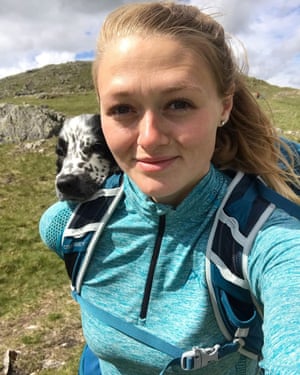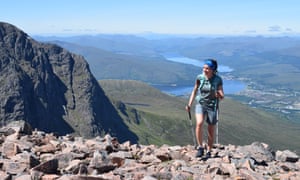Deep in the English countryside on a golden midsummer evening, 16 young people have gathered to plot the night’s entertainment. Partially organised by word of mouth, partially through WhatsApp, we have arrived ready at the meeting point – the bottom of a windmill famous for featuring in Chitty Chitty Bang Bang.
It’s a friendly, chatty, hotchpotch crowd. If I squint, I think this might just be how the halcyon days of rave first came about. It might – except that I’m here with the Berkshire Young Ramblers and we’re going on a five-mile hike. Walking, I mumble unconvincingly, is the new raving … isn’t it?
Last year the trend forecasters WGSN predicted that hiking would become the biggest new fitness trend of 2019. Buoyed by fashion houses including Gucci and Louis Vuitton putting walking boots on the catwalk and a proliferation of young models – your Hadids and Jenners – posing in Californian canyons, style blogs declared hiking to be officially hot.
That may have come as news for anyone spending their lifetime using their feet unfashionably, but the stats bear it out: while going out-out has undergone a generational decline, going to the great outdoors has seen a marked uptick among millennials.
The Ramblers, the UK walking charity best known for attracting an older demographic, counts more than 50 groups nationwide for people in their 20s and 30s – and they are growing rapidly; the Glasgow Young Walkers’ membership increased by 28% at the start of 2019 and the Stag Walkers’ (covering Hertfordshire, Bedfordshire and Cambridgeshire) by 14% in the same period. By contrast, there are just 40 groups for walkers over 40.
Social media undeniably creates homophilous bubbles of people, but the cultural shift has been perceptible – Instagram is filled with photos of beautiful craggy coastlines taken by an array of young, part-time hedonists: part-time hikers. My own feed features a fashion editor friend who spent her last pre-baby holiday climbing the peaks of Mallorca. A former editor of Vice at her happiest scaling Devil’s Dyke. Music journalists on mountains. An artist documenting their wild desert walks. A twentysomething club kid besotted with the Jurassic coast. My own amateur adventures into nature have become so frequent in the last three years that I’ve set up a separate Instagram account just to stop spamming my friends with endless postcards of endless vistas.
User research confirms that walking has become a widespread hobby.
“People have been coming to Pinterest for inspiration, for making sure they’re fully equipped for their treks,” says Larkin Brown, a spokesperson for the social media network. Searches on Pinterest for “hiking equipment” have increased by 38% in the last 12 months, while “hiking outfit” has jumped by 44%.
“People are using the platform to plan ideas for their routes – searches for ‘walking trails’ have leapt by 50%,” adds Brown.
Chris Lines, who has more than 20 years’ experience working with the outdoor brand Berghaus and the It’s Great Out There Coalition, says the surge of interest in the outdoors ties into broader consumer trends: we want to enhance our lives with greater experiences rather than more stuff. More memories, fewer hangovers. “The attraction has especially grown in the last decade,” he says, “because people want to get away from the hustle and bustle of an increasingly frenetic daily life in the city. Everyone is surrounded by technology and ‘on’ all the time; getting outdoors is a chance to put that down and reconnect with nature. It’s a mental escape as much as a physical one – and it’s good for you.”
Laura Doling, 25, is a keen champion. “Everyone talks about mental health a lot, but I think, massively for young people, it’s a great outlet to be in the hills in solitude,” she says. “Everything else becomes insignificant when I’m walking; the world carries on and it slows everything down.” Doling grew up in Jaywick, Essex, which is regularly named as one of the most deprived towns in Britain. She graduated with a first in sports science and worked in healthcare before quitting to become a Royal Mail postwoman. After finding a community of like-minded young adventurers on Instagram, she engineered a job transfer to the Lake District and now spends all day walking the fells. Her following online includes brands keen to use her influence to encourage more young people to explore nature and get active.
“I did the clubbing scene,” she says. “I don’t think it’s healthy, and I think it’s a waste of money. I can go out at a weekend and camp out in the hills, where you sit and have a decent conversation. It takes away from the superficial problem of worrying what you look like or what you’re wearing.”

Doling’s friend Nic Hardy, who describes herself as Instagram’s hiking social secretary, agrees. An IT project manager from Sheffield, Hardy quit her job and sold her house to walk, trek, ramble and mountaineer full time. “I’ve pretty much sold all my stuff or given it away and kept a few sentimental items at my mum’s. I drive around in my estate car and have everything I need; I’m 34 and I’ve never felt happier.” By flagging up her walks on Instagram, Hardy has forged a community of young walkers who regularly organise expeditions and learn from one another. “I don’t think I’ve ever met anyone who was awkward or not friendly and I’ve made so many lifelong friends.”
That walking is meditative and healing is no secret. Where Henry David Thoreau and Ralph Waldo Emerson offered literary treatises on its transcendental properties, scientific studies have confirmed that spending time outdoors in green spaces is good for you. Last month a paper published in the journal Scientific Reports found that people who spend two hours a week or more outdoors reported a greater sense of wellbeing. The month before, Forestry England compiled data from a string of studies to prove that being around trees improves mood and attention span, and enhances stress recovery. News that walking in nature aids creativity is not new. The challenge is to get more people to realise that it’s easy – and belongs to everyone.
“The industry is waking up to the fact that it needs to look and feel more inclusive and a lot more could and should be done,” says Lines. “Especially as the barrier to entry is so low – you just need to go out for a walk. There are no costs to that.”
After all, you can only be what you can see and, subconsciously, plenty of us have grown up in families assuming that outdoor adventuring is, well, for white people. To that end, Lines works to lobby for grants to fund projects “designed to give young people a lifelong love of the outdoors, reaching diverse communities that haven’t traditionally been targeted”. Berghaus, he says, already does some of this work. Meanwhile North Face has established an “explorer fund … to create access and equity in the outdoors”.

Back in the Chilterns, the Berkshire crew enthusiastically amble through stunning hills before finishing up at a village pub. Their membership has swollen by 30% in the last year, helped by younger walkers encouraged by the ease of advice available online.
But organised group walking isn’t for everyone. Plenty of us – by which I mean me – prefer a more ad hoc approach. Three years ago, after becoming free of flatmates for the very first time, I began walking home from everywhere in London and felt better, lighter, happier. A trip to Pakistan incorporated daily five-mile walks. A meander through the woods here, a three-hour stroll across the beach there followed.
Last summer, after more than a decade of pinballing through gigs and grotty parties together, my best friend fixed us a dream holiday: a week of walking along the Normandy coast, a single backpack each. Dorks on walks we may be, but she – the more committed and inspiring of us both – insists it’s ridiculous to describe her as a “walker”.
“It still sounds like something people in their middle age do. I’m never getting the sticks,” she says. “Going walking and getting into nature is just about getting away from the city. You’ve got to get far enough away from London to feel disconnected and get the views.”
To paraphrase Jean Jacques Rousseau, it’s easier to meditate while walking. “When I stop, I cease to think; my mind only works with my legs.”
Source: TheGuardian
